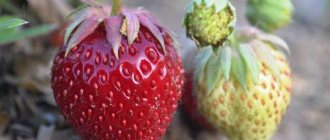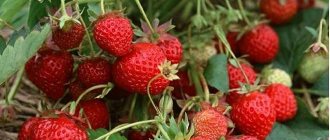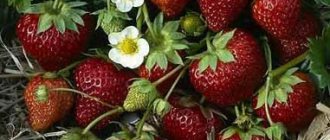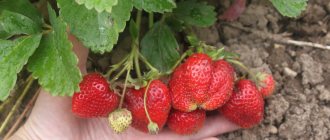Strawberry Gigantella - description and care of a large-fruited variety
Many gardeners are engaged in growing strawberries with large fruits. But they argue that such berry crops require special care and if the basic requirements are not followed, the bushes will dry out, the fruits will become smaller, and the yield will sharply decrease.
One of these “capricious” strawberry varieties is Gigantella, by the name of which you can already judge the huge size of its berries.
The content of the article:
1. History of the creation of the variety 2. Main characteristics and description of the variety 3. Productivity of the variety 4. Diseases and pests 5. Agricultural technology for growing the variety 6. Advantages and disadvantages 7. Reviews of Gigantella strawberries
Farmers' reviews about the Gigantella variety
Gardeners speak positively about the strawberry variety in question. Farmers note the large size of the berries and the plant's resistance to frost. The culture sells well and customers like it more than many other analogues. At the same time, gardeners point out the need for timely watering and protection from pests. Otherwise, all efforts will come to nothing.
Previous
StrawberriesGrowing features, description and characteristics of Albion strawberries
Next
StrawberriesDescription and nuances of growing strawberries Zenga Zengana
History of the variety's creation
It is believed that the Gigantella variety is the fruit of selection by specialists from the Netherlands, who gave the name to this strawberry Gigantella Maxim.
Later, after the appearance of the variety on the Russian market, this name was transformed into Gigantella maxi, Gigantella Maxim, and some sellers simply call it Maxim and claim that
Gigantella and Maxim are completely different varieties, but in fact this is not the case.
Despite the fact that this variety appeared on the Russian market quite a long time ago, it was never included in the State Register.
Therefore, the main characteristics, description of the Gigantella strawberry variety and rules for caring for this berry crop are taken from the description of Dutch experts and reviews of gardeners who have been growing this variety on their plots for a long time.
Photo of strawberry Gigantella
In addition, you need to take into account that varieties with large fruits require special growing conditions; they grow better, and the fruits actually appear large in a warm southern climate on loose soils with a sufficient amount of nutrients. In regions with colder climates, it is recommended to plant Gigantella strawberries in greenhouse conditions and create all the conditions for abundant fruiting: water and fertilize on time, loosen and mulch the soil, remove weeds and tendrils that deplete the mother bushes, and as a result the fruits become smaller.
Description
When creating the variety, Dutch breeders dreamed of getting mid-season strawberries with huge fruits. They succeeded quite well.
Strawberry Gigantella in the description of the variety, photos and reviews from gardeners fully corresponds to the real results. And this contributes to the growing popularity of the variety.
- The strawberry bush is powerful, spreading, its height can be almost half a meter, so the plants are not planted close.
- The leaves of the Gigantella Maxim variety are large, juicy green, shiny, and slightly corrugated.
- Gigantella begins to bear fruit in open ground in the second half of July, when grown under film 2 weeks earlier. One strawberry bush produces up to 30 flower stalks. Each of them blooms from 6 to 8 flowers.
- It produces a harvest only once, but due to large berries weighing up to 60 and sometimes up to 100 grams, it meets the expectations of gardeners.
- The berries are bright scarlet, with white specks, dense, juicy. You can determine that the Gigantella strawberries have almost reached the desired condition by looking at the nose, which gradually turns from white to scarlet. The fruits are very sweet, with a subtle pineapple aftertaste.
- Strawberries of the Gigantella variety can be grown in one place for no more than 8 years.
Main characteristics and description of the Gigantella strawberry variety
Strawberry Gigantella belongs to the medium-late varieties in terms of ripening, not remontant, fruiting is extended. Gigantella is a short-day variety.
The fruits begin to ripen in late June; in general, fruiting lasts a couple of weeks.
Interesting!
Gardeners consider the main advantage of this strawberry to be the gigantic size of the fruit - the weight of one berry can reach 100 g.
Photo of Gigantella strawberry bushes
The bushes are quite tall and voluminous - they can reach 0.6 m in height, so they need to be planted at a considerable distance from each other. The foliage is large, slightly wrinkled, rich green in color, shiny, its edges are torn and corrugated. In the second season, reddish stains may appear on the upper side of the leaf blades.
The bushes grow quickly, the formation of mustaches in the Gigantella strawberry is average; in the process of growth and ripening of the fruit, they should be removed so that the fruits ripen truly gigantic. The sockets are well attached to the ground.
The shape of the ripening berries is comb-like, the sides are flattened, the size of the fruit is large. The first ripe berries are the largest - up to 100 g, later the weight of the berries decreases to 40-60 g. The skin is slightly rough, the seeds are yellow, clearly visible. The color of ripe berries is bright red. The pulp is quite dense, sweet, has no voids, matte, deep red. The aroma of ripe berries is faintly noticeable.
During transportation, the berries do not lose their presentation and do not produce juice.
From the harvested crop you can make preserves, jams and compotes; ripe berries of this strawberry can be frozen for long-term storage. Berries do not lose their appearance and taste when frozen.
The bushes require professional care; if it is disturbed, you may not get large berries. Also, Gigantella strawberry bushes do not tolerate periods of drought and extreme heat. At such times, the amount of watering should be increased, and the bushes should be shaded from the hot rays of the sun. In addition, this berry crop is susceptible to various diseases and attacks by insect pests.
In one area, Gigantella strawberries can grow for up to 8 seasons, and then they should be transplanted to a new place. Thanks to the good formation of the mustache, there are no problems with the propagation and planting of plantations of this berry crop.
THIS IS INTERESTING!
• Article about
the 15 best varieties of strawberries
Harvest Features
Gigantella berries have the following distinctive features:
- Very large size and impressive weight.
- Beautiful appearance, slightly pressed oval shape. Bright red color and the presence of white or yellowish seeds on the surface.
- The berries taste sweet and juicy.
- The elastic structure of the fruit allows it to maintain its original shape for a long time.
Usually about 50 berries are harvested from one Gigantella bush, the total weight of which can be approximately 5 kg.
Diseases and pests
Experts say that this variety is resistant to some diseases that affect other strawberry varieties. But Gigantella’s resistance to some fungal diseases is below average. This applies, in particular, to gray rot. At the first symptoms of this disease, diseased plants are immediately removed and destroyed. And healthy bushes and soil are treated with a solution of fungicidal preparations (Fitosporin and other similar ones).
And also this berry crop can be affected by chlorosis (its non-infectious form). In this case, strawberry bushes are treated with a solution of preparations containing iron.
Chlorosis on strawberries - video
In spring and autumn, bushes of this variety must be treated for preventive purposes with Bordeaux mixture - a 2% solution.
Of the pests, the most dangerous for Gigantella strawberry plantations are:
- moles;
- mole crickets;
- slugs;
- snails
To repel pests, you can scatter onion or garlic peels between the rows.
The following plants can also be planted for these purposes:
- marigold;
- onion;
- parsley;
- celery.
Plant care
There are no particular difficulties when growing Gigantella strawberries. Gardeners write about this in their reviews. Agricultural technology is almost identical to other varieties. Although some nuances when growing Gigantella strawberries are still worth paying attention to:
- The bush grows rapidly, throwing out a huge number of mustaches. If you want a good harvest, you should remove them as they appear. To obtain planting material, a few bushes are enough. They only add 5 tendrils for rooting, so as not to weaken the mother bush.
- Gigantella is also grown using the carpet method, rooting all the mustaches. New rosettes, as the foliage grows, begin to produce flower stalks and produce a harvest in the first year.
Attention! Strawberry Gigantella is undemanding to planting and care.
Useful tips
- If the strawberries are planted simply in the ground (the bed is not covered with black non-woven material), it is necessary to remove the weeds in a timely manner.
- Water the plants once every 7 days.
- Diseased strawberry bushes should be removed immediately.
- Before setting fruit, the soil must be mulched to prevent rotting of garden strawberries.
- To grow a rich harvest, do not forget about fertilizing before fruiting. Water the bushes with sodium sulfate and nitrophoska. Repeated feeding is carried out after harvesting with nitrophos and wood ash.
- Frost-resistant Gigantella strawberries do not need to be covered for the winter. It keeps well under snow.
Warning! There is no need to tear off old leaves; they are a kind of insulation for the roots.
Agricultural technology for growing strawberry variety Gigantella
The place for this strawberry should be sunny, protected from gusts of cold winds, level, without stagnant moisture. The Gigantella variety is not planted in the lowlands. It is better if the soil on the site is light (loam, sandstone, black soil) and quite fertile.
Before planting, dig up the area, break up the clods, and apply fertilizer. Seedlings can be planted in the last ten days of April or in the first ten days of September. When applying fertilizers to strawberries, the main thing is not to apply a large amount of nitrogen fertilizers.
Transplanting Gigantella strawberries - video
The bushes grow quickly, but at the same time they produce a large number of tendrils, which must be removed immediately in order for the plants to ripen the fruits properly. The mustache for further propagation of the variety should be grown in the second half of summer, after fruiting has ended.
After the snow has melted, the bushes are inspected, plant debris and dry leaves are removed, and treated with fungicidal preparations for preventive purposes.
Fungicidal drug!
• Fungicide Antrakol - instructions for use and processing rules.
Onion peels are laid out between the rows, and then fertilizing is applied.
Pine needles or straw are laid around the bushes so that the introduced moisture evaporates more slowly.
Against possible pest attacks during the summer season, Gigantella bushes are treated with Fitosporin at least 5 times.
In the spring, compost is laid out under the bushes, which is a source of easily digestible nitrogen. During the bud blooming period, these strawberries will be fertilized with a solution of any potassium salt.
Important!
To increase the yield of Gigantella strawberry bushes, the plants are treated with a solution of boric acid during the flowering period.
After harvesting, be sure to feed this berry crop with a complex mineral fertilizer containing potassium and phosphorus.
Caring for strawberries after harvest - video
Features of planting and growing
The variety is propagated in two classical ways: seeds and seedlings.
Propagation by seeds
Strawberries are planted as seedlings in mid-February.
- First, drainage (1–2 cm) is placed at the bottom of the box. The most popular option is expanded clay.
- Pour a 12–15 cm layer of fertile soil.
- Make grooves 0.5 cm deep in the soil, sow seeds in them and thoroughly water them.
Strawberry seeds are sown in fertile soil and watered
- Then sprinkle 1 cm of soil on top.
- Strawberries are very demanding of moisture. The soil must be kept slightly moist.
- The first green shoots appear after 20–25 days. As soon as this happens, the box must be placed in a well-lit place and remember to maintain the required level of humidity and temperature (20–25°C).
To maintain the optimal temperature, the container with the seedlings can be covered with film, ventilating regularly
- Strawberries are picked, planted in pots, when the first true leaf appears on the plant.
- Planting in open ground is carried out in May, in the phase of 4–5 leaves.
Strawberries are ready for planting when 4–5 leaves form on the seedlings
Recent Entries
5 working ways to use tar in the garden 7 indoor plants that help you get married even in adulthood Indoor plants that can bloom in trouble
Propagation by seedlings
First of all, you need to choose the right healthy seedlings. To do this, you need to pay attention to several signs:
- at least 2–3 young leaves;
- the leaves should be a natural green color, leathery, with slight pubescence. Pale leaves are a sign of a fungal disease;
- Avoid seedlings with wrinkled leaves. This is a sign of a tick infestation;
- The length of the roots should be at least 7 cm or occupy the entire volume of the glass if you decide to buy seedlings with a closed root system.
Before planting seedlings in open ground, the soil must be cultivated, especially if this area has not been cultivated before. Site preparation begins in the fall. It is recommended to treat the soil with a continuous herbicide. This will allow you to reliably get rid of perennial weeds. In October, the soil is dug up, and in the spring, before planting, it is harrowed to a depth of 15 cm. The soil is enriched with ash, humus, compost or specialized fertilizers from garden stores.
It is better to plant strawberries in early spring. Autumn planting is carried out from mid-August to mid-September. Gigantella is unpretentious to soil composition, but will grow better on light loamy soil. Strawberries love the sun, so you should choose well-lit areas for planting. It is preferable to plant seedlings after rain or in well-drained soil. Maintain a distance of 25–30 cm between bushes.
Watering
In order for strawberries to take root, it is important to keep the soil constantly moist for 2 weeks. Therefore, watering is carried out daily. Subsequently, strawberry plantings are watered once every 2 days. In the absence of sufficient moisture in the soil, productivity decreases significantly. The best option for strawberries is to install a drip irrigation system. But it is also worth remembering that excess moisture increases the risk of infection with fungal diseases (powdery mildew, gray mold). Mulching the soil with sawdust and straw will help solve the weeding problem.
During the summer, the bush throws out numerous tendrils, which must be cut off immediately if you plan to get a good harvest.
Mulching strawberry beds retains moisture in the soil and prevents weed growth
Feeding
In the first year, strawberries need to be fed during flowering and fruit formation. A complex fertilizer for berries is suitable. The next year, the bushes can be fertilized with saltpeter (100 g per 10 m2); in the third year, potassium, superphosphate and saltpeter can be added in equal proportions. The soil is fertilized in two stages: one half is applied in early spring, the second half after harvesting.
Disease Prevention
Gigantella is rarely susceptible to disease, but preventive measures will not harm the bushes:
- in the spring, onion peels are scattered between the bushes - it will repel pests and serve as fertilizer;
- You can use pine needles as mulch - it will both protect the plant and protect the berries from contact with the ground;
- crushed horse sorrel is poured into 10 liters of hot water, then left for 2 days. The filtered solution is sprayed onto the bushes;
- to protect against weeds and nematodes, marigolds can be planted between the ridges;
- onions or garlic planted between strawberry bushes will protect the plants from gray rot.
Onions are a good neighbor for strawberries, protecting them from gray rot and pests
Video: secrets of growing strawberries
Advantages and disadvantages of Gigantella strawberries compared to other varieties
The advantages of this variety include:
- high productivity;
- huge size of berries;
- excellent taste and presentation of ripe fruits;
- good resistance to frost;
- the harvested crop tolerates transportation well over long distances without releasing juice;
- ripe fruits are of universal use.
Gigantella also has a number of disadvantages:
- bushes require frequent watering, especially in hot weather;
- be sure to feed the plants throughout the season;
- the variety has low resistance to gray rot and non-infectious chlorosis;
- it is necessary to remove the mustache during the fruiting period.
General recommendations for growing large-fruited varieties
The listed names of garden strawberries claim leadership in the category of huge strawberries. There are many competitors, including Russian selection. Agricultural technicians, farmers, and gardeners advise beginning summer residents planning to grow such berries:
- High frost resistance is considered to be the ability of a crop to withstand frosts of 20-25 degrees, provided there is good snow cover. Therefore, in anticipation of a winter with little snow, the beds are covered, snow retention means are organized, and snow is thrown onto the strawberry plantation.
- Unpretentiousness does not mean that strawberries will grow gigantic in size on their own. Pre-planting preparation of land for beds and fertilizing in summer and winter are mandatory measures to maintain crop productivity.
- Large-fruited strawberries love a lot of water. If there is little moisture, voids form inside and the taste deteriorates. With excess moisture, acidity and wateriness appear. The beds are allowed to dry 2-3 cm deep and watered abundantly. More often in hot or dry summers.
- The number and size of berries directly depend on the number of whiskers. By cutting out shoots in time, the summer resident increases productivity. For propagation, model bushes are selected: they are not allowed to bloom so that the mustaches with rosettes become stronger.
Large-fruited strawberries are often not remontant, but they break yield records due to heavy berries.
Strawberry Gigantella: reviews from those who planted
There are quite a lot of reviews about the Gigantella strawberry variety on the forums. Below are just a few of them.
Daria, 27 years old, Moscow:
“My mother grew different varieties of strawberries in our garden plot, and a few years ago she planted a bed of Gigantella. And we fell in love with this variety - large, sweet fruits and high yield were the main positive features of this strawberry. But it should be noted that in order to achieve high yields, this berry crop needs to be constantly looked after, in particular, watered little by little, but often. Next year we plan to install drip irrigation on Gigantella’s beds.”
STRAWBERRY varieties!
• large-fruited Malvina • Strawberry CORONA • early ripening variety DUKAT • Noble strawberry VIKODA • early strawberry Darenka
Olga, 56 years old, Suzdal:
“My grandchildren are looking forward to when the fruits of Gigantella begin to ripen. Of all the varieties of strawberries growing in the garden, they like this one. For those who are just starting to grow this variety on their plot, I would like to give advice: do not apply large amounts of nitrogen-containing fertilizers to the strawberry bushes. Somehow I got carried away with adding urea, as a result the bushes grew huge and produced a large number of runners, but we didn’t get a good harvest this season. Interestingly, Gigantella is called both strawberry and strawberry.”
Ekaterina, 30 years old, Ryazan:
“I’ve only been growing strawberries for a couple of seasons. I planted Gigantella on the plot, but the result disappointed me - the bushes grew well, but the berries were few and not very large. But it turned out that I myself was to blame for this - I fed it with nitrogen fertilizers in the spring when preparing the beds. I left the bed with this variety to overwinter and covered it before the onset of cold weather so that the bushes would not freeze. Let’s see how the Gigantella strawberries will bear fruit next year.”
We can say that the Gigantella variety is high-yielding only with appropriate care, so novice gardeners before planting this berry crop should familiarize themselves with the rules for growing and further caring for this strawberry.
And only if all the rules are followed, Gigantella will definitely pamper its owners with large, sweet fruits and high yields.
Planting strawberries in the ground
Since the Gigantella strawberry fruits are quite large, it is clear that it needs good nutritious soil. In this case, the harvest will correspond to the characteristics in all respects. The plant likes loamy soils, into which organic matter or mineral fertilizers have been added.
The predecessors of Gigantella strawberries can be plantings of peas, beans, beans, and lentils. It’s even better to plant plants in soil that has been given a season to rest. In central Russia, plants can be planted in open ground at the end of April, beginning of May, since the remontant variety is frost-resistant.
Immediately before planting strawberries, the soil is spilled with water and holes for seedlings are marked.
Comment! Only 4 Gigantella strawberry bushes are planted per square meter.
When planting plants, pay attention to the planting depth. The growing points should remain above the surface of the loose soil. Look at the photo below how a gardener does this.
Characteristics of the variety
Strawberries are mid-season varieties and are in deserved demand among amateur gardeners. Description of the strawberry variety “Gigantella”:
- The culture is distinguished by its abundant growth and large fruits (hence the name).
- Requires frequent watering, but does not tolerate waterlogging of the root system.
- "Gigantella" needs periodic treatment against diseases and garden pests.
- Strawberries are resistant to fungal infections.
- Prefers areas of land exposed to the sun.
- Tolerates low temperatures well.
- "Gigantella" grows in open ground.
- Fruits early, flowers appear in mid-May.
- Due to self-pollination, it has high productivity.
- Due to the density of the fruit, strawberries are well preserved after picking and during transportation.
Attention! When purchasing strawberry seedlings, it is recommended to know that “Gigantella”, “Maxim” and “Dutch” are the names of the same crop variety.
Drought and frost resistance
The strawberry variety "Gigantella" is frost-resistant, which gives it the opportunity to grow in most of Russia. If the temperature does not drop below -20 °C, the variety will safely overwinter. In those regions where a drop to 30°C is possible, it is necessary to take care of shelter. A special material, lutrasil, is suitable for this purpose. Protection of Gigantella is necessary in the first spring months if there is a risk of frost. During flowering of the variety, even zero temperature can lead to the death of the plant.
The Maxim variety prefers timely watering. With a lack of moisture and hot weather, the ability of pollen to fertilize is lost and yields drop. The fruits, leaves, and root systems dry out—the strawberries may die. At high humidity, the roots rot, the berries stop growing and fall off. If the harvest can be harvested, the berry is watery and loses its taste.
Productivity and fruiting
One bush of the Gigantella variety produces up to 30 fruiting parts, each of which can have 8 flowers. The fruits are formed in mid-May or June - depending on the region of growth and compliance with agrotechnical requirements. The first berries appear after 2 weeks if the spring is warm or after 20 days if the temperature is low.
About 35 berries are harvested from one bush - this is 3-4 kg. In the southern regions the figure is higher - the collection reaches 6 kg. On average per 1 sq. m the yield will be 20–30 kg. This takes into account the fact that no more than 4 seedlings can be placed in such an area, since the “Gigantella” variety grows quickly and takes up a lot of space.
The amount of harvest and size of berries can be affected by:
- the climate is too hot - without watering, the quality of strawberries will be unsatisfactory;
- rainy summer - the Gigantella variety does not tolerate waterlogging;
- spring frosts;
- improper care and neglect of treatment against diseases.
Important! Properly chosen soil is the key to a good harvest. Strawberries of this variety will not grow in swampy areas and clay soil.
Area of application of berries
Gigantella can be consumed fresh. It is well suited for homemade preparations: preserves, jams, compotes, syrups, marmalade. Retains its shape and beneficial properties when frozen. Thanks to its medicinal properties, it regulates cholesterol, maintains the elasticity of blood vessels, and counteracts fatty liver. Cosmetic masks are also prepared from the berries.
Resistance to diseases and pests
According to its characteristics, the Gigantella strawberry is no different from other representatives of the berry crop - without pre-treatment and preventive work, it is susceptible to bacterial and fungal diseases. The smell attracts rodents and insects.
Advantages and disadvantages of the variety
Positive aspects of Gigantella strawberries:
- large fruits;
- high productivity;
- early maturation;
- specific taste;
- dense pulp;
- moderate juiciness;
- suitable for freezing and homemade preparations;
- strawberries are well stored and transported;
- unpretentious in care;
- frost-resistant variety.
Disadvantages relate to the process of growing Gigantella strawberries:
- requires a comfortable temperature regime and timely moderate watering;
- not suitable for regions with harsh winters and late spring;
- predisposed to diseases;
- attracts garden pests;
- Strawberries become smaller as the plant ages.
The Gigantella variety is not suitable for industrial cultivation.











